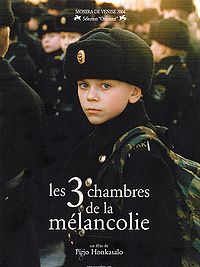
THE THREE ROOMS OF MELANCHOLIA
Finland, 2004, 106 minutes, Colour.
Directed by Pirjo Honkasalo.
The Three Rooms of Melancholia is a documentary feature. It is spoken in Russian, Chechen, Arabic and Finnish. The director is Finnish, and has made a number of documentaries. She decided to go to Russia and Chechnya to film stories about the conflict between the republic trying to rebel and Russia.
Her first room of melancholia (Longing) is set in a school set up just outside St Petersburg. Established by President Putin, it is for young (very young) orphans who are to do military training. The focus is on discipline, a severe kind of life for young boys. Several of them are introduced by name and their backgrounds given. However, at the core of the story is the focus of the animosity of the orphans – and its being geared towards Chechnya and Chechen rebels.
The second room of melancholia is in Grozny itself and is filmed in black and white (Breathing). The scenes of devastation of apartment blocks, street by street, in Grozny are both dismaying and alarming. Western audiences know about the destruction in Chechnya but probably have not had the opportunity to spend some time actually contemplating the ruins, the consequent difficult way of life, the poverty of the survivors, their attitude towards the brutality of the Russian soldiers.
This is taken up in the third room of melancholia, set in the neighbouring small republic of Ingushtia (Remembering). The contrast between the rolling hills with the shepherds and the distant mountains of the Caucasus, form a contrast with the ruins of Grozny even though this is only four kilometres from the Chechen border. The film focuses on a woman, who had been an orphan herself, who now gathers together orphans in Grozny, brings them to a shelter and helps them find a new way of life. Since Chechnya is an Islamic republic, there is an emphasis on the mosque, on the men praying, on the role of religion for both men and women and, especially, in the training of the children.
The director has drawn on Scandinavian technical advice and help for her putting the film together. It screened at the Venice Film Festival during the very time when the Chechen rebels took the hostages at the school at Belsen with a death toll of over 300 people, including many of the children. It could not have been more topical.
1.The impact of the film? Topical for 2004? Documentary/fiction?
2.The director, a women’s perspective, perspective of a documentary film-maker, a director from Finland looking at the Caucasus and Russia?
3.The style of the film, semi-documentary, the focus on faces, situations? Colour and lighting? The focus on St Petersburg, the school and the island? The contrast with the black and white photography of the second section? Grozny in ruins? The third section and the refugee camp, the contrast with the open hills and mountains of the Caucasus? The musical score?
4.The title of the film, the three stories, their interconnection? The theme of melancholy as well as the separate titles of Longing, Breathing, Remembering?
5.The impact of the Longing story: the island, St Petersburg, the military traditions, President Putin and the designation of the orphanage, the training of the orphans in military style? Their young age? The focus on the individuals, the explanation of their background, age, orphans, experience, exploitation? The details of life in the school, early rise, washing, drills? Military activities and training? Their going to the city? Their being the hope of the future for Russia? Chechnya as the imagined enemy? The comment on Russian militarism?
6.The second story, the graphic depiction of Grozny in ruins, the long tracking shots along the streets, apartment block after apartment block in ruins? The gradual emergence of the people, the children playing with guns and military games? The women trying to get food? The people wandering? The few cars? Life in Grozny, struggling? The café and the child eating the meal, the care of the mother? The introduction to different characters? Their explanation of the effect of the war, the Russians? The brutality of the Russian soldiers, raping and sexual violence?
7.The story of Hadizhat, her collecting the orphans, her manner, bringing them together, out of the ruins? Her own background of being in a Russian children’s home when she was six?
8.The transition in the third part with remembering: the Republic of Ingushetia, four kilometres from the border with Chechnya? The small republic? The refugees from Chechnya? Hadishat and her having a centre for the orphans?
9.The contrast with the mountainous countryside, the scenes with the shepherds and the sheep? The towns and survival, the rural areas? The pathos of the long shots of people’s faces and experience in Ingushetia?
10.The difficulties in filming, during the war, the security, permissions? The risk and its good effect in being able to show the world something of the realities of Chechnya and its suffering?